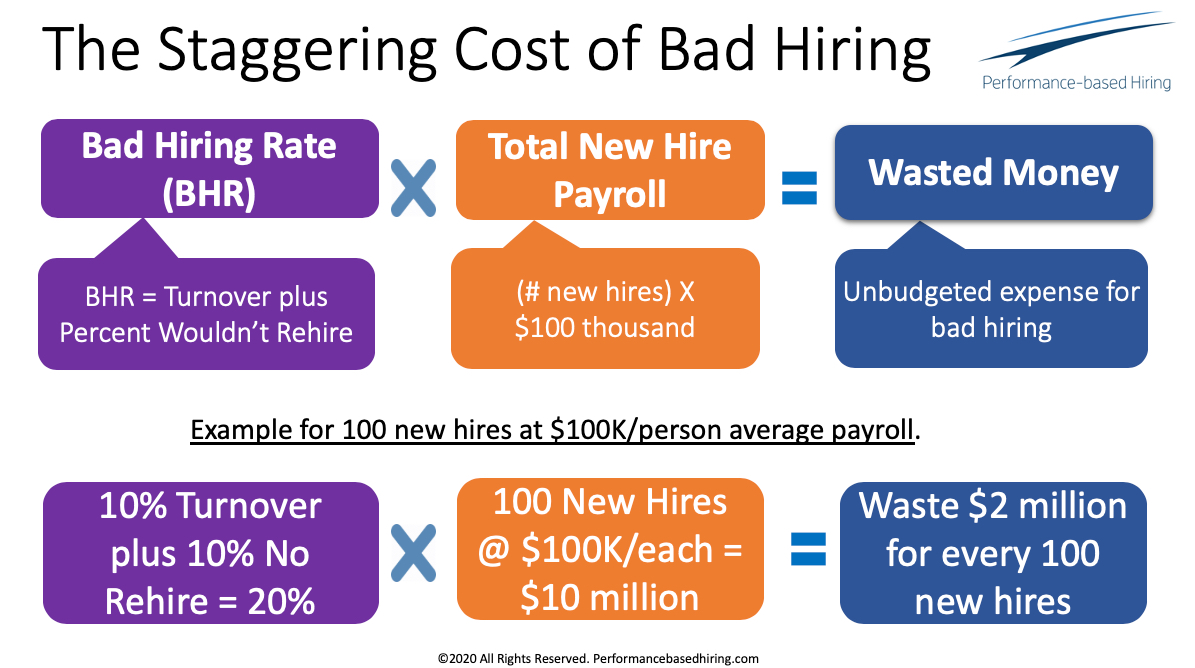While inquiring about the status of a hiring manager interview training proposal, a client told me she would get back to me as soon as they got their new budget approved. As part of our discussion I asked this important question:
What is the company’s budget for bad hires?
I’ve asked this same question many times and always get pretty much the same answer:
We don’t have one.
This case was no different. However, I followed up by saying that getting a rough estimate of the cost of bad hiring decisions was easy to calculate. All you have to do is multiple the percent of people who shouldn’t have been hired in the first place by the company’s total annual increase in payroll costs for new hires.
This process is shown in the graphic.

For example, to calculate the Bad Hiring Rate just add the actual turnover rate to the percent of people who are still there but you wouldn’t rehire. She said this total was about 20 percent. To get an estimate of annual payroll expense multiply the number of people hired in the year by $100 thousand. This is the typical average total payroll expense per person for non-hourly admin, professional and managerial staff.
Given this, she said they hired 100 people in the past 12 months which equates to $10 million in additional annual payroll. This is equivalent to an unbudgeted waste of $2 million every year for bad hiring decisions – 20% of $10 million! That got her attention.
This is still a conservative estimate since it does not reflect the opportunity cost of not hiring the right person and the chaos caused by hiring the wrong person. But as a starting point it’s a good floor to use to determine the companywide impact of bad hiring decisions.
I then suggested she could save much of this annual waste by doing just these six things at the cost of pennies on the dollar or less:
- Clarify expectations before approving the requisition. Performance is problematic if candidates are hired without a clear understanding of the performance objectives of the job beforehand. Every job can be defined by 5-6 key performance objectives (KPOs) that define the task, what needs to be done and some deliverable or measure of success. These are also called OKRs (Objectives and Key Results) which are commonplace throughout the technology world. The problem is that most people don’t create them until after the hire. However, they have game-changing impact when described before the hire since the new hire and every interviewer knows what’s expected of the person before anyone is offered the job or accepts it.
- Measure past performance, not depth of knowledge. Interview accuracy will soar when you ask candidates to provide detailed examples of accomplishments most related to these KPOs or OKRs.
- Don’t invite anyone onsite until the hiring manager conducts a phone screen. An exploratory phone screen focused on fit, performance and potential can not only save time and reduce the impact of first impressions, but also helps convince strong passive candidates that the opening is worth further investigation. This is a huge “win-win” since stronger candidates will now be seen.
- Replace the 30-minute get-to-know-you sessions masquerading as interviews with organized panel interviews. A well-organized panel interview with 3-4 people is the best way to increase assessment accuracy by reducing bias and giving everyone the chance to hear the same evidence. An unorganized panel is as much a waste of time as the series of 30-minute interviews.
- Make sure all interviewers justify their decisions in a live formal debriefing session. Emotional decisions and bias of all kinds can be hidden in a written summary or a thumb up or down. Requiring people to explain their decisions sharing their evidence with this type of multi-factor scorecard can reveal potential hiring mistakes long before any offer is made.
- Ask candidates to justify their decisions before making the offer. To focus on the merits of the job rather than the compensation ask candidates why they want the job. Take comfort when a candidate can describe the KPOs/OKRs in detail and why they represent challenging and motivating work. Be concerned when the candidate talks in generalities. This is a clue that on-the-job performance and satisfaction will be problematic.
Since hiring mistakes are rarely budgeted but always happen these simple steps should be built into every company’s standard hiring practices. Not only will they save millions, more important, they’ll help your company hire the right people for the right reasons, not just the compensation package.

